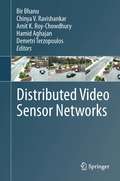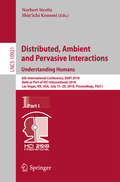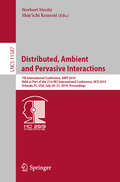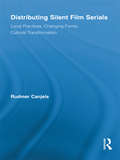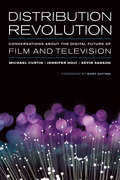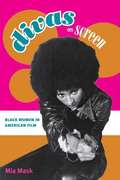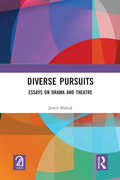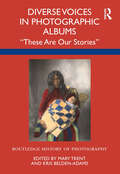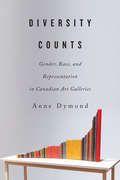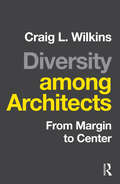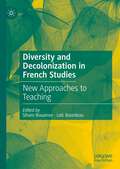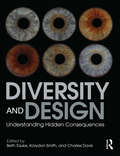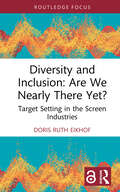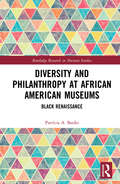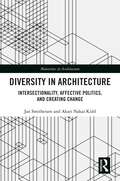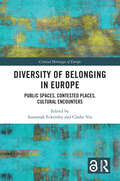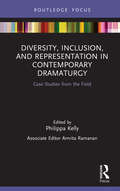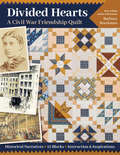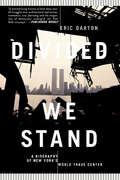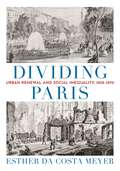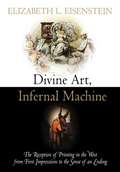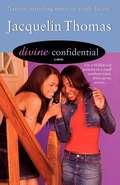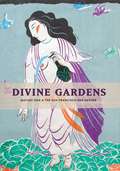- Table View
- List View
Distributed Video Sensor Networks
by Bir Bhanu Demetri Terzopoulos Amit K. Roy-Chowdhury Hamid Aghajan Chinya V. RavishankarLarge-scale video networks are of increasing importance in a wide range of applications. However, the development of automated techniques for aggregating and interpreting information from multiple video streams in real-life scenarios is a challenging area of research. Collecting the work of leading researchers from a broad range of disciplines, this timely text/reference offers an in-depth survey of the state of the art in distributed camera networks. The book addresses a broad spectrum of critical issues in this highly interdisciplinary field: current challenges and future directions; video processing and video understanding; simulation, graphics, cognition and video networks; wireless video sensor networks, communications and control; embedded cameras and real-time video analysis; applications of distributed video networks; and educational opportunities and curriculum-development. Topics and features: presents an overview of research in areas of motion analysis, invariants, multiple cameras for detection, object tracking and recognition, and activities in video networks; provides real-world applications of distributed video networks, including force protection, wide area activities, port security, and recognition in night-time environments; describes the challenges in graphics and simulation, covering virtual vision, network security, human activities, cognitive architecture, and displays; examines issues of multimedia networks, registration, control of cameras (in simulations and real networks), localization and bounds on tracking; discusses system aspects of video networks, with chapters on providing testbed environments, data collection on activities, new integrated sensors for airborne sensors, face recognition, and building sentient spaces; investigates educational opportunities and curriculum development from the perspective of computer science and electrical engineering. This unique text will be of great interest to researchers and graduate students of computer vision and pattern recognition, computer graphics and simulation, image processing and embedded systems, and communications, networks and controls. The large number of example applications will also appeal to application engineers.
Distributed, Ambient and Pervasive Interactions: 6th International Conference, DAPI 2018, Held as Part of HCI International 2018, Las Vegas, NV, USA, July 15–20, 2018, Proceedings, Part I (Lecture Notes in Computer Science #10921)
by Norbert Streitz Shin’ichi KonomiThis two volume set constitutes the refereed proceedings of the 6th International Conference on Distributed, Ambient and Pervasive Interactions, DAPI 2018, held as part of the 20th International Conference on Human-Computer Interaction, HCII 2018, held in Las Vegas, NV, USA in July 2018. The total of 1171 papers and 160 posters presented at the 14 colocated HCII 2018 conferences. The papers were carefully reviewed and selected from 4346 submissions. These papers address the latest research and development efforts and highlight the human aspects of design and use of computing systems. The papers thoroughly cover the entire field of Human-Computer Interaction, addressing major advances in knowledge and effective use of computers in a variety of application areas.. The LNCS 10921 and LNCS 10922 contains papers addressing the following major topics: Technologies and Contexts ( Part I) and Understanding Humans (Part IΙ)
Distributed, Ambient and Pervasive Interactions: 7th International Conference, DAPI 2019, Held as Part of the 21st HCI International Conference, HCII 2019, Orlando, FL, USA, July 26–31, 2019, Proceedings (Lecture Notes in Computer Science #11587)
by Norbert Streitz Shin’ichi KonomiThis book constitutes the refereed proceedings of the 7th International Conference on Distributed, Ambient and Pervasive Interactions, DAPI 2019, held as part of the 21st International Conference on Human-Computer Interaction, HCII 2019, in Orlando, Florida, USA, in July 2019. A total of 1274 papers and 209 posters have been accepted for publication in the HCII 2019 proceedings from a total of 5029 submissions. The 36 papers included in this volume were organized in topical sections on IoT and big data; smart cities and built environments; perception and emotion in DAPI; and DAPI for health and learning.
Distributed, Collaborative, and Federated Learning, and Affordable AI and Healthcare for Resource Diverse Global Health: Third MICCAI Workshop, DeCaF 2022, and Second MICCAI Workshop, FAIR 2022, Held in Conjunction with MICCAI 2022, Singapore, September 18 and 22, 2022, Proceedings (Lecture Notes in Computer Science #13573)
by M. Jorge Cardoso Shadi Albarqouni Spyridon Bakas Islem Rekik Bennett Landman Nicola Rieke Holger Roth Daguang Xu Bishesh Khanal Debdoot Sheet Xiaoxiao Li Sophia Bano Chen QinThis book constitutes the refereed proceedings of the Third MICCAI Workshop on Distributed, Collaborative, and Federated Learning, DeCaF 2022, and the Second MICCAI Workshop on Affordable AI and Healthcare, FAIR 2022, held in conjunction with MICCAI 2022, in Singapore in September 2022. FAIR 2022 was held as a hybrid event.DeCaF 2022 accepted 14 papers from the 18 submissions received. The workshop aims at creating a scientific discussion focusing on the comparison, evaluation, and discussion of methodological advancement and practical ideas about machine learning applied to problems where data cannot be stored in centralized databases or where information privacy is a priority. For FAIR 2022, 4 papers from 9 submissions were accepted for publication. The topics of the accepted submissions focus on deep ultrasound segmentation, portable OCT image quality enhancement, self-attention deep networks and knowledge distillation in low-regime setting.
Distributing Silent Film Serials: Local Practices, Changing Forms, Cultural Transformation (Routledge Advances in Film Studies)
by Rudmer CanjelsTracing the international consumption, distribution, and cultural importance of silent film serials in the 1910s and 1920s, Canjels provides an exciting new understanding of the cultural dimension and the cultural transformation and circulation of media forms. Specifically, he demonstrates that the serial film form goes far beyond the well-known American two-reel serial—the cliffhanger. Throughout the book, Canjels focuses on the biggest producers of serials, America, France, and Germany, while imported serials, such as those in the Netherlands, are also examined. This research offers new views on the serial work of well known directors as D.W. Griffith, Abel Gance, Erich von Stroheim, and Fritz Lang, while foregrounding the importance of lesser known directors such as Louis Feuillade or Joe May. In the early twentieth-century, serial productions were constantly undergoing change and were not merely distributed in their original form upon import. As adjusted serials were present in large quantities or confronted different social spaces, nationalistic feelings and views stimulated by the unrest of World War I and the expanding American film industry could be incorporated and attached to the serial form. Serial productions were not only adaptable to local discourses, they could actively stimulate and interact as well, influencing reception and further film production. By examining the distribution, reception, and cultural contexts of American and European serials in various countries, this cross-cultural research makes both local and global observations. Canjels thus offers a highly relevant case study of transnational, transcultural and transmedia relations.
Distribution Revolution
by Jennifer Holt Kevin Sanson Michael CurtinDistribution Revolution is a collection of interviews with leading film and TV professionals concerning the many ways that digital delivery systems are transforming the entertainment business. These interviews provide lively insider accounts from studio executives, distribution professionals, and creative talent of the tumultuous transformation of film and TV in the digital era. The first section features interviews with top executives at major Hollywood studios, providing a window into the big-picture concerns of media conglomerates with respect to changing business models, revenue streams, and audience behaviors. The second focuses on innovative enterprises that are providing path-breaking models for new modes of content creation, curation, and distribution--creatively meshing the strategies and practices of Hollywood and Silicon Valley. And the final section offers insights from creative talent whose professional practices, compensation, and everyday working conditions have been transformed over the past ten years. Taken together, these interviews demonstrate that virtually every aspect of the film and television businesses is being affected by the digital distribution revolution, a revolution that has likely just begun. Interviewees include: * Gary Newman, Chairman, 20th Century Fox Television * Kelly Summers, Former Vice President, Global Business Development and New Media Strategy, Walt Disney Studios * Thomas Gewecke, Chief Digital Officer and Executive Vice President, Strategy and Business Development, Warner Bros. Entertainment * Ted Sarandos, Chief Content Officer, Netflix * Felicia D. Henderson, Writer-Producer, Soul Food, Gossip Girl * Dick Wolf, Executive Producer and Creator, Law & Order
Divas on Screen: Black Women in American Film
by Mia MaskThis insightful study places African American women's stardom in historical and industrial contexts by examining the star personae of five African American women: Dorothy Dandridge, Pam Grier, Whoopi Goldberg, Oprah Winfrey, and Halle Berry. Interpreting each woman's celebrity as predicated on a brand of charismatic authority, Mia Mask shows how these female stars have ultimately complicated the conventional discursive practices through which blackness and womanhood have been represented in commercial cinema, independent film, and network television. Mask examines the function of these stars in seminal yet underanalyzed films. She considers Dandridge's status as a sexual commodity in films such as Tamango, revealing the contradictory discourses regarding race and sexuality in segregation-era American culture. Grier's feminist-camp performances in sexploitation pictures Women in Cages and The Big Doll House and her subsequent blaxploitation vehicles Coffy and Foxy Brown highlight a similar tension between representing African American women as both objectified stereotypes and powerful, self-defining icons. Mask reads Goldberg's transforming habits in Sister Act and The Associate as representative of her unruly comedic routines, while Winfrey's daily television performance as self-made, self-help guru echoes Horatio Alger narratives of success. Finally, Mask analyzes Berry's meteoric success by acknowledging the ways in which Dandridge's career made Berry's possible.
Diverse Pursuits: Essays on Drama and Theatre
by Javed MalickThe five essays in this book reflect many years of the author's sustained academic engagement with dramatic forms and traditions. The opening essay traces the historical trajectory of modern drama in Europe from its bourgeois period through the period of the liberal dissent to the more recent periods of radical alternative. The subsequent essays deal with certain specific examples of that drama in India and the West, such as Shakespeare adaptations on the Parsi theatre stage, Habib Tanvir, and Samuel Beckett. The author places each of these in a historical perspective. This approach constitutes the theoretical underpinning of the book giving cohesion to this collection of diverse essays. Although they were individually published in various journals and books in their earlier versions, they have been substantially revived and updated by the author for this volume. Please note: Taylor & Francis does not sell or distribute the Hardback in India, Pakistan, Nepal, Bhutan, Bangladesh and Sri Lanka.
Diverse Voices in Photographic Albums: “These Are Our Stories” (Routledge History of Photography)
by Mary TrentThrough a variety of case studies by global scholars from diverse academic fields, this book explores photographic-album practices of historically marginalized figures from a range of time periods, geographic locations, and socio-cultural contexts. Their albums' stories span various racial, ethnic, gender and sexual identities; nationalities; religions; and dis/abilities. The vernacular albums featured in this volume present narratives that move beyond those reflected in our existing histories. Essays examine the visual, material, and aural strategies that album-makers have used to assert control over the presentation of their histories and identities, and to direct what those narratives have to say, a point of special relevance as these albums move out of private domestic space and into public archives, institutions, and digital formats. This book does not consider photographic albums and scrapbooks as separate genres, but as a continuum of modern creative practices of photographic and mass-print collage aimed at self-expression and narrative-building that co-evolved and were readily accessible. The book will be of interest to scholars working in art history, history of photography, visual culture, material culture, media studies, and cultural studies.
Diversity Counts: Gender, Race, and Representation in Canadian Art Galleries
by Anne DymondDespite the common belief that art galleries will naturally become more gender equitable over time, the fact is that many art institutions in Canada have become even less so over the last decade, with female artists making up less than 25 per cent of the contemporary exhibitions of several major galleries. In the first large-scale overview of gender diversity in Canadian art exhibitions, Anne Dymond makes a persuasive plea for more consciously equitable curating. Drawing on data from nearly one hundred institutions, Diversity Counts reveals that while some galleries are relatively equitable, many continue to marginalize female and racialized artists. The book pursues an interdisciplinary approach, considering the art world's resistance to numeric data, discourses on representation and identity, changing conceptualizations of institutional responsibility over time, and different ways particular institutions manage inclusion and exclusion. A thoughtful examination of the duty of public galleries to represent underserved communities, Dymond's study bravely navigates the unspoken criteria for acceptance in the curatorial world. Demonstrating how important hard data is for inclusivity, Diversity Counts is a timely analysis that brings the art world up to date on progressive movements for social transformation.
Diversity Counts: Gender, Race, and Representation in Canadian Art Galleries
by Anne DymondDespite the common belief that art galleries will naturally become more gender equitable over time, the fact is that many art institutions in Canada have become even less so over the last decade, with female artists making up less than 25 per cent of the contemporary exhibitions of several major galleries. In the first large-scale overview of gender diversity in Canadian art exhibitions, Anne Dymond makes a persuasive plea for more consciously equitable curating. Drawing on data from nearly one hundred institutions, Diversity Counts reveals that while some galleries are relatively equitable, many continue to marginalize female and racialized artists. The book pursues an interdisciplinary approach, considering the art world's resistance to numeric data, discourses on representation and identity, changing conceptualizations of institutional responsibility over time, and different ways particular institutions manage inclusion and exclusion. A thoughtful examination of the duty of public galleries to represent underserved communities, Dymond's study bravely navigates the unspoken criteria for acceptance in the curatorial world. Demonstrating how important hard data is for inclusivity, Diversity Counts is a timely analysis that brings the art world up to date on progressive movements for social transformation.
Diversity among Architects: From Margin to Center
by Craig WilkinsDiversity among Architects presents a series of essays questioning the homogeneity of architecture practitioners, who remain overwhelmingly male and Caucasian, to help you create a field more representative of the population you serve. The book is the collected work of author Craig L. Wilkins, an African American scholar and practitioner, and discusses music, education, urban geography, social justice, community design centers, race-space identity, shared landscape, and many more topics.
Diversity and Decolonization in French Studies: New Approaches to Teaching
by Loïc Bourdeau Siham BouamerThis edited volume presents new and original approaches to teaching the French foreign-language curriculum, reconceptualizing the French classroom through a more inclusive lens. The volume engages with a broad range of scholars to facilitate an understanding of the process of French (de)colonization as well as its reverberations into the postcolonial era, and a deeper engagement with the global interconnectedness of these processes. Chapters in Part I revist the concept of the "francophonie," decenter the field from “metropolitan” or “hexagonal” and white France and underline how current teaching materials reproduce epistemic and colonial violence. Part II adopts an intersectional approach to address topics of gender inclusivity, trans-affirming teaching, queer materials, and ableism. Finally, Part III presents new ways to transform the discipline by affirming our commitment to social justice and making sure that our classrooms are representative of our students’ enriching diversity.
Diversity and Design: Understanding Hidden Consequences
by Beth Tauke, Korydon Smith, and Charles DavisDiversity and Design explores how design - whether of products, buildings, landscapes, cities, media, or systems - affects diverse members of society. Fifteen case studies in television, marketing, product design, architecture, film, video games, and more, illustrate the profound, though often hidden, consequences design decisions and processes have on the total human experience. The book not only investigates how gender, race, class, age, disability, and other factors influence the ways designers think, but also emphasizes the importance of understanding increasingly diverse cultures and, thus, averting design that leads to discrimination, isolation, and segregation. With over 140 full-color illustrations, chapter summaries, discussion questions and exercises, Diversity and Design is a valuable tool to help you understand the importance of designing for all.
Diversity and Inclusion: Target Setting in the Screen Industries (Routledge Research in the Creative and Cultural Industries)
by Doris Ruth EikhofThis book provides the first compact knowledge base on diversity & inclusion (D&I) targets in the UK screen industries. Drawing on new, in-depth industry research and progressive theoretical voices, the book will help readers understand what D&I targets are and what they could be in the future. The book explains different types of D&I targets, how D&I targets are currently used and how they might be developed to strategically drive inclusion. D&I targets are an increasingly common feature of the screen industries, but there is little evidence and guidance on how to use them well. This book addresses that gap. The book offers, for the first time, a unifying terminology for D&I target setting in the UK screen industries, including for transorganisational D&I targets (targets set by one organisation for another). It is based on a cross-industry review of D&I target setting in the UK screen industries, using evidence from industry and academic research. Providing a unique knowledge base on diversity & inclusion targets in the UK screen industries, this book will be of value to researchers, industry experts, practitioners, policy makers, campaigners and anyone who needs to understand D&I targets – to advise on them, to set and achieve them and to advocate for their effective, inclusive use.
Diversity and Philanthropy at African American Museums: Black Renaissance (Routledge Research in Museum Studies)
by Patricia A. BanksDiversity and Philanthropy at African American Museums is the first scholarly book to analyze contemporary African American museums from a multifaceted perspective. While it puts a spotlight on the issues and challenges related to racial politics that black museums collectively face in the 21st century, it also shines a light on how they intersect with corporate culture, youth culture, and the broader cultural world. Turning the lens to philanthropy in the contemporary era, Banks throws light on the establishment side of African American museums and demonstrates how this contrasts with their grassroots foundations. Drawing on over 80 in-depth interviews with trustees and other supporters of African American museums across the United States, this book offers an inside look at the world of cultural philanthropy. While patrons are bound together by being among the distinct group of cultural philanthropists who support black museums, the motivations and meanings underlying their giving depart in both subtle and considerable ways depending on race and ethnicity, profession, generation, and lifestyle. Revealing not only why black museums matter in the eyes of supporters, the book also complicates the conventional view that social class drives giving to cultural nonprofits. It also paints a vivid portrait of how diversity colours cultural philanthropy, and philanthropy more broadly, in the 21st century. Diversity and Philanthropy at African American Museums will be a valuable resource for scholars and practitioners engaged with African American heritage. It will also offer important insights for academics, as well as cultural administrators, nonprofit leaders, and fundraisers who are concerned with philanthropy and diversity.
Diversity in Architecture: Intersectionality, Affective Politics, and Creating Change (Minorities in Architecture)
by Jan Smitheram Akari Nakai KiddDiversity in Architecture: Intersectionality, Affective Politics, and Creating Change explores diversity in architecture through an intersectional lens. It examines how overlapping individual identities, cultural ideologies, and institutional practices shape the profession.Divided into two parts, this book first explores how values, norms, and ideologies are constructed, circulated, and reinforced through media representations – both from without and from within. The second leans into voices from academics and architects within spaces of education and practice, who share their lived experiences navigating power structures and affective politics that marginalise diverse voices. Considering praxis and actions to create change where care is central, it asks: what happens if we bring intersectionality to the picture of diversity in architecture – through media, education, practice? How can affective solidarity and relationality foster change? What role does intersectional care play in dismantling systemic barriers and reimagining a more inclusive future? Written in dialogue with, and for architectural academics, practitioners, students, as well as wider audiences invested in diversity, this book opens its readers to the importance of mobilising diversity in architecture through intersectionality and affect, towards lasting change.
Diversity of Belonging in Europe: Public Spaces, Contested Places, Cultural Encounters (Critical Heritages of Europe)
by Susannah Eckersley and Claske VosDiversity of Belonging in Europe analyses conflicting notions of identity and belonging in contemporary Europe. Addressing the creation, negotiation and (re)use of diverse spaces and places of belonging, the book examines their fascinating complexities in the context of a changing Europe. Taking an innovative interdisciplinary approach, the volume examines renegotiations of belonging played out through cultural encounters with difference and change, in diverse public spaces and contested places. Highlighting the interconnections between social change and of culture, heritage and memory, chapters analyse multilayered public spaces and the negotiations over culture and belonging that are connected to them. Through analyses of diverse case studies, the editors and authors draw out the significance of the participation or exclusion of differing community, grassroots and activist groups in such practices and discourses of belonging in relation to the contemporary emergence of identity conflicts and political uses of the past across Europe. They analyse the ways in which people’s sense of belonging is connected to cultural, heritage and memory practices undertaken in different public spaces, including museums, cultural and community centres, city monuments and built heritage, neglected urban spaces, and online fora. Diversity of Belonging in Europe provides a valuable contribution to the existing bodies of work on identities, migration, public space, memory and heritage. The book will be of interest to scholars and students with an interest in contested belonging, public spaces and the role of culture and heritage.
Diversity, Inclusion, and Representation in Contemporary Dramaturgy: Case Studies from the Field (Focus on Dramaturgy)
by Philippa Kelly Amrita RamananDiversity, Inclusion, and Representation in Contemporary Dramaturgy offers fresh perspectives on how dramaturgs can support a production beyond rigid disciplinary expectations about what information and ideas are useful and how they should be shared. The sixteen contributors to this volume offer personal windows into dramaturgy practice, encouraging theater practitioners, students, and general theater-lovers to imagine themselves as dramaturgs newly inspired by the encounters and enquiries that are the juice of contemporary theater. Each case study is written by a dramaturg whose body of work explores important issues of race, cultural equity, and culturally-specific practices within a wide range of conventions, venues, and communities. The contributors demonstrate the unique capacity of their craft to straddle the ravine between stage and stalls, intention and impact. By unpacking, in the most up-to-date ways, the central question of “Why this play, at this time, for this audience?,” this collection provides valuable insights and dramaturgy tools for scholars and students of Dramaturgy, Directing, and Theater Studies.
Divided Hearts: A Civil War Friendship Quilt
by Barbara BrackmanThe fascinating story of Civil War friendships across the Mason-Dixon line from the bestselling author and “renowned quilt historian” (Time).Create your own historically inspired friendship quilt with twelve popular blocks from the Civil War era. Each album block comes with design variations and an optional center flourish, plus setting instructions. Read compelling narratives of the women who found their hearts divided during the war, yet left a legacy of friendship quilts as proof of their bond.“Inspired by friendship quilts created between 1840 and 1861, Brackman focuses on women with ‘divided hearts,’ Northern women living in the South, and Southern women educated in the North, or with families divided by the Civil War . . . readers learn about twelve women’s lives that spanned the divide. Photographs and maps accompany the biographies. History comes alive through these women . . . You don’t have to be a quilt maker to enjoy reading the history and biographies of these amazing women.” —The Literate Quilter“The historical narratives about the women are so interesting . . . The quilts are beautiful and I love the idea of a friendship quilt . . . [an] amazing book.” —Crafty Moms Share
Divided We Stand: A Biography of New York's World Trade Center
by Eric DartonWhen the World Trade Towers in New York City were erected at the Hudson’s edge, they led the way to a real estate boom that was truly astonishing. Divided We Stand reveals the coming together and eruption of four volatile elements: super-tall buildings, financial speculation, globalization, and terrorism. The Trade Center serves as a potent symbol of the disastrous consequences of undemocratic planning and development. This book is a history of that skyscraping ambition and the impact it had on New York and international life. It is a portrait of a building complex that lives at the convergence point of social and economic realities central not only to New York City but to all industrial cities and suburbs. A meticulously researched historical account based on primary documents, Divided We Stand is a contemporary indictment of the prevailing urban order in the spirit of Jane Jacobs’s mid-century classic The Death and Life of Great American Cities.
Dividing Paris: Urban Renewal and Social Inequality, 1852–1870
by Esther da Costa MeyerA groundbreaking work of scholarship that sheds critical new light on the urban renewal of Paris under Napoleon IIIIn the mid-nineteenth century, Napoleon III and his prefect, Georges-Eugène Haussmann, adapted Paris to the requirements of industrial capitalism, endowing the old city with elegant boulevards, an enhanced water supply, modern sewers, and public greenery. Esther da Costa Meyer provides a major reassessment of this ambitious project, which resulted in widespread destruction in the historic center, displacing thousands of poor residents and polarizing the urban fabric.Drawing on newspapers, memoirs, and other archival materials, da Costa Meyer explores how people from different social strata—both women and men—experienced the urban reforms implemented by the Second Empire. As hundreds of tenements were destroyed to make way for upscale apartment buildings, thousands of impoverished residents were forced to the periphery, which lacked the services enjoyed by wealthier parts of the city. Challenging the idea of Paris as the capital of modernity, da Costa Meyer shows how the city was the hub of a sprawling colonial empire extending from the Caribbean to Asia, and exposes the underlying violence that enriched it at the expense of overseas territories.This marvelously illustrated book brings to light the contributions of those who actually built and maintained the impressive infrastructure of Paris, and reveals the consequences of colonial practices for the city's cultural, economic, and political life.
Divine Art, Infernal Machine: The Reception of Printing in the West from First Impressions to the Sense of an Ending
by Elizabeth L. EisensteinThe author has written a magisterial and highly readable account of five centuries of ambivalent attitudes toward printing and printers. Once again, she makes a compelling case for the ways in which technological developments and cultural shifts are intimately related.
Divine Confidential
by Jacquelin ThomasDivine is used to getting what she wants.... Thanks to her loving Aunt Phoebe and Uncle Reed, Divine Matthews-Hardison has a place to call home after the Hollywood life she was accustomed to fell apart at the seams. Getting away from the spotlight that nearly destroyed her own parents, Divine has changed for the better -- though there's still enough diva in Divine to keep life in Temple, Georgia, very lively, from mall shopping with her cousin Alyssa and her fashion-challenged aunt, to worshipping at her uncle's church, to dating. But what if it's too much too soon? Divine has boys on the brain and she's itching for a social life -- at least as much as is allowed under Uncle Reed's watchful eyes. She knows she's too young for the kind of secretive drama her cousin Chance is going through with his girlfriend, but still.... Turning to the internet, Divine gets a major crush on sixteen-year-old Sean, who sounds and looks like the perfect guy. But she is about to learn a difficult -- and potentially dangerous -- lesson: Things are not always what they appear to be....
Divine Gardens: Mayumi Oda and the San Francisco Zen Center
by Mayumi OdaKnown to many as "the Matisse of Japan," Mayumi Oda combines traditional Japanese and Buddhist iconography with her own unique sense of color, line, and movement. In this collection, her groundbreaking artwork is paired with essays by San Francisco Zen Center and Green Gulch Farm Zen Center practitioners (including Richard Baker, Linda Ruth Cutts, Wendy Johnson, Edward Espe Brown, and Norman Fischer) who have owned, loved, and been changed by Oda's work over the years.Mayumi Oda's internationally-recognized artwork plays with traditional Japanese and Buddhist images, refiguring them as celebrations of the feminine and the natural world. Where most traditional Buddhist iconography features male figures, Oda introduces female "Goddesses" that seem to jump off the page, imbued with the vibrancy of Oda's color and line.Originally from Japan, Oda settled in Muir Beach, California in the 1970s and began practicing and painting at Green Gulch Farm Zen Center, which Oda calls her "California Buddha Field." Divine Gardens pairs Oda's artwork with essays by her fellow practitioners, for whom Oda's artwork has been a constant companion. Suitable for study by art students or for display on a coffee table, Divine Gardens captures the essence of Mayumi Oda's art and life as a Zen practitioner. The forty-five full-color works of art and twenty-four essays contained in the collection are a joyful celebration of her work and the community forged through the years at the San Francisco Zen Center.
